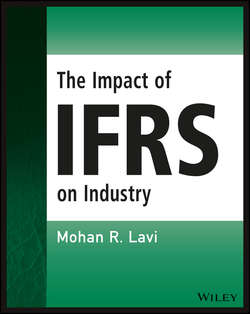Читать книгу The Impact of IFRS on Industry - Lavi Mohan R. - Страница 14
На сайте Литреса книга снята с продажи.
Chapter 2
Summary of Disclosures Under IFRS Standards
2.6 IFRS 8 Segment Reporting
ОглавлениеAn entity shall disclose information to enable users of its financial statements to evaluate the nature and financial effects of the business activities in which it engages and the economic environments in which it operates.
An entity shall disclose the following for each period for which a statement of comprehensive income is presented:
a. general information as described,
b. information about reported segment profit or loss, including specified revenues and expenses included in reported segment profit or loss, segment assets, segment liabilities and the basis of measurement,
c. reconciliations of the totals of segment revenues, reported segment profit or loss, segment assets, segment liabilities and other material segment items to corresponding entity amounts.
Reconciliations of the amounts in the statement of financial position for reportable segments to the amounts in the entity's statement of financial position are required for each date at which a statement of financial position is presented. Information for prior periods shall be restated.
2.6.1 General Information
An entity shall disclose the following general information:
a. factors used to identify the entity's reportable segments, including the basis of organisation (for example, whether management has chosen to organise the entity around differences in products and services, geographical areas, regulatory environments, or a combination of factors and whether operating segments have been aggregated);
b. the judgements made by management in applying the aggregation criteria. This includes a brief description of the operating segments that have been aggregated in this way and the economic indicators that have been assessed in determining that the aggregated operating segments share similar economic characteristics; and
c. types of products and services from which each reportable segment derives its revenues.
2.6.2 Information About Profit or Loss, Assets and Liabilities
An entity shall report a measure of profit or loss for each reportable segment. An entity shall report a measure of total assets and liabilities for each reportable segment if such amounts are regularly provided to the chief operating decision maker. An entity shall also disclose the following about each reportable segment if the specified amounts are included in the measure of segment profit or loss reviewed by the chief operating decision maker, or are otherwise regularly provided to the chief operating decision maker, even if not included in that measure of segment profit or loss:
a. revenues from external customers;
b. revenues from transactions with other operating segments of the same entity;
c. interest revenue;
d. interest expense;
e. depreciation and amortisation;
f. material items of income and expense disclosed in accordance with IAS 1 Presentation of Financial Statements (as revised in 2007);
g. the entity's interest in the profit or loss of associates and joint ventures accounted for by the equity method;
h. income tax expense or income; and
i. material non-cash items other than depreciation and amortisation.
An entity shall report interest revenue separately from interest expense for each reportable segment unless a majority of the segment's revenues are from interest and the chief operating decision maker relies primarily on net interest revenue to assess the performance of the segment and make decisions about resources to be allocated to the segment. In that situation, an entity may report that segment's interest revenue net of its interest expense and disclose that it has done so.
An entity shall disclose the following about each reportable segment if the specified amounts are included in the measure of segment assets reviewed by the chief operating decision maker or are otherwise regularly provided to the chief operating decision maker, even if not included in the measure of segment assets:
a. the amount of investment in associates and joint ventures accounted for by the equity method; and
b. the amounts of additions to non-current assets1 other than financial instruments, deferred tax assets, net defined benefit assets (see IAS 19 Employee Benefits) and rights arising under insurance contracts.
